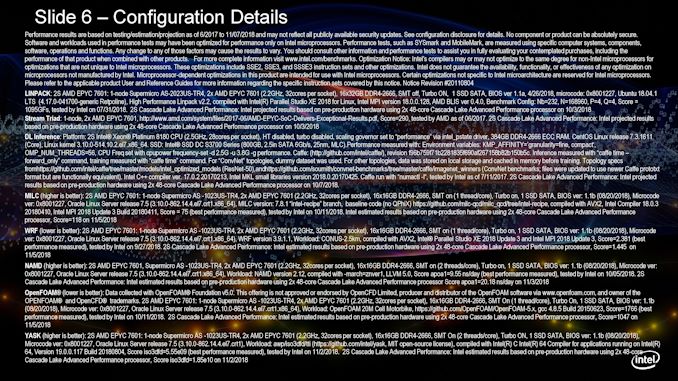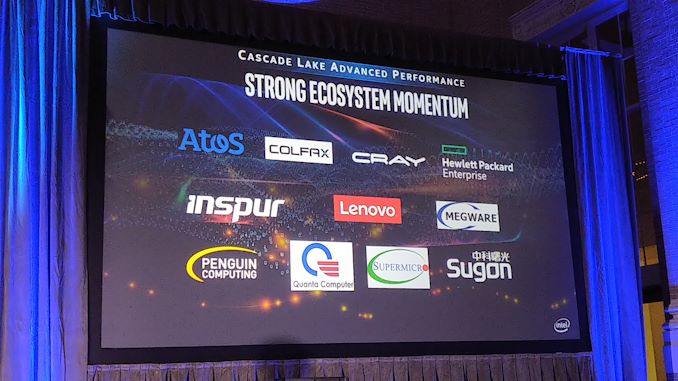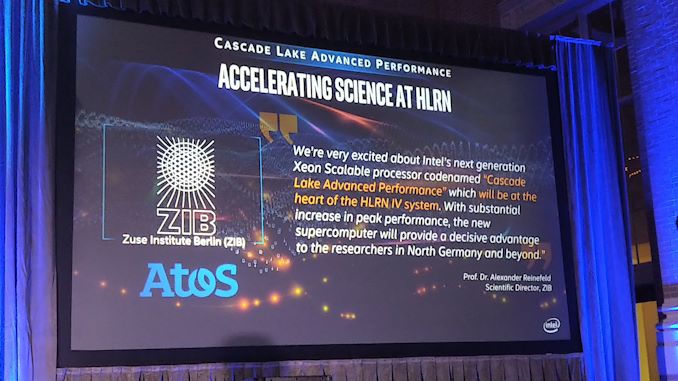Intel Offers More Cascade Lake-AP Performance Numbers
by Ian Cutress on November 11, 2018 6:15 PM EST- Posted in
- Enterprise
- Intel
- HPC
- Enterprise CPUs
- Cascade-AP

One of the announcements from last week involved Intel and its new Cascade Lake Advanced Performance category of processors to launch next year. These new processors will be based on combining two 24-core Cascade Lake-SP processors on a single package substrate to offer a single socket 48-core option with a total of twelve memory channels. The Cascade Lake-AP parts are going to be launched next year, and until then Intel is putting out some internal benchmark numbers.
Vendor Benchmark Results
When we are this far away from a product launch, all benchmark numbers should be taken with a grain of salt. This goes doubly so for vendor supplied benchmarks. However, Intel is on the warpath to promote what it sees as a new product family within its portfolio, even if it is only set to come out next year.
At the announcement last week, Intel offered Linpack and Stream Triad as two main high-performance metrics as comparison. Today Intel is also offering more ‘real world’ metrics. These metrics are, to quote Intel, ‘estimates based on pre-production hardware’. This means that the hardware is not ready yet, and these are values based on the engineering samples running but extrapolated to an expected benchmark value. Add another dump truck of salt on these numbers.
Intel’s official list of results are as follows:
| Intel's Benchmark Numbers for 2S 48 Core Cascade Lake-AP |
||
| Benchmark Type | Score vs 2S EPYC 7601 | |
| *These numbers were created by Intel | ||
| Linpack | Numerical Linear Algebra | 3.4x |
| Stream Triad | Memory Bandwidth | 1.3x |
| MILC | Quantum Chromodynamics | 1.5x |
| WRF | Weather Forcasting | 1.6x |
| OpenFOAM | Computational Fluid Dynamics | 1.6x |
| NAMD (APOA1) | Molecular Dynamics | 2.1x |
| YASK (ISO 3DFD) | HPC Kernel Tuning | 3.1x |
The slide with this data is in the gallery below.
In each case, Intel is comparing a dual-socket Cascade Lake-AP system with a dual socket EPYC 7601 system. Intel’s information slides go through how it set up all of its AMD systems in detail, however it does not disclose how the Cascade Lake-AP systems are set up by comparison, presumably as to not disclose any additional set-up numbers.
For the most part, we don’t put much stock into vendor supplied benchmark numbers. It’s easy for a vendor to claim a multiple when doubling particular compute resources, but when it comes to real world tests, companies like Intel have to try and promote its future products to potential customers. This is what this is. However, no matter how many numbers come out, these are impossible to verify independently. Wait until the AnandTech review, of course.
Intel also disclosed a number of ecosystem partners who are getting ready to deploy Cascade Lake-AP, as well as an offical declaration of the Cascade Lake-AP deployment at HLRN.
Cascade Lake-AP is set to be launched alongside the Cascade Lake-SP in the first part of 2019, although Intel states that Cascade Lake-SP will ship for revenue in 2018. This week we are at the Supercomputing trade show - hopefully there will be a demo somewhere that we’ll be able to see and talk about.



















52 Comments
View All Comments
The Hardcard - Sunday, November 11, 2018 - link
No “Cash Out Of Your Pocket” benchmark? What’s the multiplier versus EPYC on that?boeush - Sunday, November 11, 2018 - link
Translation: Intel is getting worried, like, for reals this time.Good.
Urthor - Sunday, November 11, 2018 - link
I mean they hired Jim Keller how long ago? They knew exactly what was comingFritzkier - Sunday, November 11, 2018 - link
7 months ago is not "long" if you are talking about development process...Lolimaster - Monday, November 12, 2018 - link
Jim Keller mumbo jumbo is 2022 at the earliest.Gondalf - Monday, November 12, 2018 - link
Too much, 2021 is more in line with a cpu developmentLolimaster - Monday, November 12, 2018 - link
1st they need a proper 10 Ice-Lake family then sub10nm Tiger Lake, then JK-lake.quadrivial - Monday, November 12, 2018 - link
If Jim Keller said ANYTHING about upcoming AMD products, he would be fiscally ruined and would never work anywhere again.Alexvrb - Monday, November 12, 2018 - link
He wouldn't need to say anything. He could just say "Look we're taking two of these and cramming together."*bangs two expensive chips into each other for emphasis*
"Doesn't that seem like... overkill?"
"No."
FredWebsters - Wednesday, December 26, 2018 - link
I think that the products that AMD do - are very useful products!